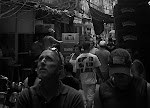Wednesday, December 12, 2012
Here I Am
Tuesday, July 10, 2012
Abdelkader Fasok
Sunday, May 27, 2012
Postus interruptus
To those of you who've emailed to ask why I've neglected this site in recent months, I appreciate your interest and apologize for the long lapses. I've been consumed with the book tour for We're With Nobody, which I co-authored with Michael Rejebian (that's us in the green room with Jon Stewart before our appearance on "The Daily Show," which was by far the highlight of the tour). Most of my posts have been for the book's website, www.werewithnobody.com. The tour is over, and I had expected to get back in the saddle here, but a new book project has presented itself, so my posts will no doubt concern that, though they will likewise be sporadic because the book project is on a very tight deadline.
The new book is about the work of photographer Tim Hetherington, a great man who was killed in a mortar attack in Misrata, Libya, on April 20, 2011. That's Tim, above, climbing out of a building in Misrata shortly before he was killed.
I'll be traveling to Misrata in June, and hope to be able to post from there. For now, I'm immersed in research, so I probably won't be posting much. I appreciate everyone's interest, and again, apologize for the long lapses.
Saturday, March 10, 2012
Warren County moves to demolish listed historic plantation house
Ceres Plantation, a rare surviving example of a pre-Civil War plantation house complex, is slated for demolition despite its 2011 listing by the Mississippi Heritage Trust among the state's 10 Most Endangered Historic Properties -- and despite efforts of preservationists to find a buyer to restore or move the buildings.
The Warren County Port Commission in the 1980s bought Ceres Plantation, located near the I-20 crossing of the Big Black River in the community of Flowers, Mississippi, with plans to develop the property into an industrial park, using the Greek Revival house as its centerpiece, hopefully for a corporate headquarters. Afterward, the Port Commission abandoned the house and allowed it to deteriorate, and in 2010 announced its plans to demolish the house and outbuildings.
It quickly became obvious that the commission had little interest in working with preservationists to save the structure, which remains in sound condition despite superficial rot that has occurred in the last decade. That led the Trust to include Ceres in its endangered list.
As preservationists continued searching for a buyer to restore or move the house, the Port Commission announced, though a series of nondescript ads in the classified section of the Vicksburg Post, that it will take bids for "demolition and removal" of Ceres and ancillary buildings. The commission posted the request for bids on March 6, 2012, though the opening date appears to be April 12.
Ceres anchored a large, working cotton plantation as recently as the early 1980s -- one of the few remaining examples in Mississippi where an antebellum home retained the archetypal view of broad cotton fields from its wide front gallery. The resulting Ceres industrial park was largely a boondoggle, with most of its sites still undeveloped after almost three decades. The Ceres house, despite its proximity to the Flowers exit on I-20, affording it a high-profile location for potential appropriate development, was allowed to languish.
Now, unless preservationists can intervene, the house appears doomed, despite the fact that the industrial park was built with federal funds, which cannot be used to destroy a federally listed historic property. The Port Commission has resisted any effort to have the house listed in the National Register of Historic Places, though it is likely eligible, and in many, if not most cases, eligible properties are afforded the same level of protection as structures that are already listed. In addition to its architectural significance, Ceres was used as a refuge by several notable Vicksburg residents during that city's Civil War siege. The plantation was founded in the 1820s by the Flowers family, who sold the house and land to the Port Commission in 1986 for an ultimately underutilized project named the Ceres Research and Industrial Interplex.
To contact the Warren County Port Commission: 601/631-0555; P.O. Box 820363, Vicksburg MS 39182. The executive director of the Port Commission is Wayne Mansfield. The board of directors, two of which are appointed by the county supervisors, two by the mayor of Vicksburg, and one by the governor, are Johnny Moss, Oren Bailess, John Ferguson, Mike Cappaert and Russell Hawkins. Note: The sad end to this story can be found here: http://misspreservation.com/2012/05/14/warren-county-port-commission-spending-29000-to-demolish-recycle-ceres/
Monday, January 9, 2012
We're With Nobody the book: Open Season: Politics, America, and Two Guys Chasing the Truth
If you haven't checked out the website for my new book with coauthor Michael Rejebian, you can find out about it (and watch the book trailer) here: www.werewithnobody.com. The book, which is about doing political opposition research across the U.S., will be published by HarperCollins on Jan. 24.
Subscribe to:
Comments (Atom)







